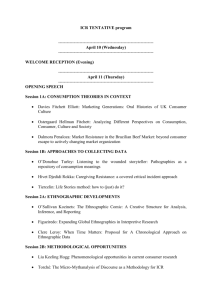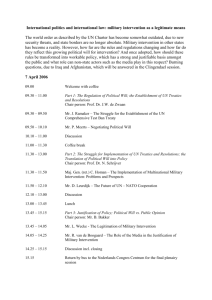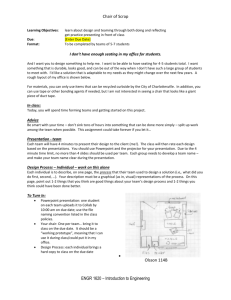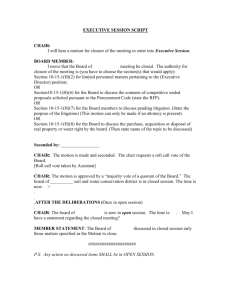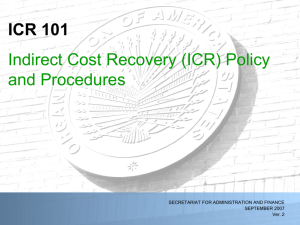OEA/Ser - Organization of American States
advertisement
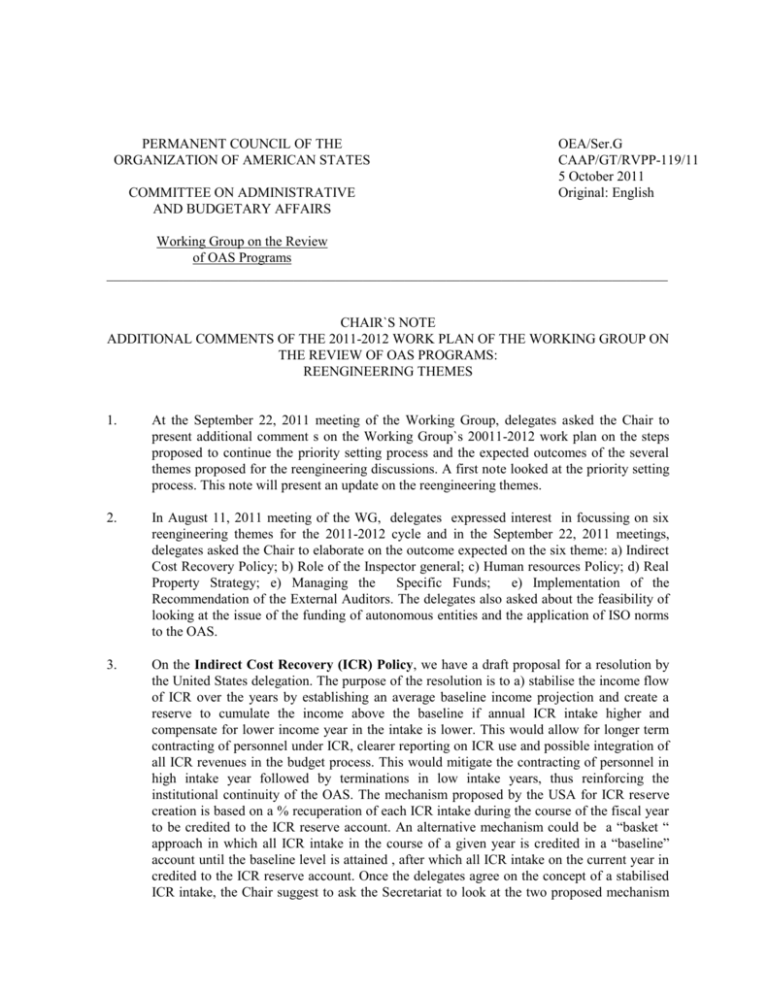
PERMANENT COUNCIL OF THE ORGANIZATION OF AMERICAN STATES COMMITTEE ON ADMINISTRATIVE AND BUDGETARY AFFAIRS OEA/Ser.G CAAP/GT/RVPP-119/11 5 October 2011 Original: English Working Group on the Review of OAS Programs _________________________________________________________________________________ CHAIR`S NOTE ADDITIONAL COMMENTS OF THE 2011-2012 WORK PLAN OF THE WORKING GROUP ON THE REVIEW OF OAS PROGRAMS: REENGINEERING THEMES 1. At the September 22, 2011 meeting of the Working Group, delegates asked the Chair to present additional comment s on the Working Group`s 20011-2012 work plan on the steps proposed to continue the priority setting process and the expected outcomes of the several themes proposed for the reengineering discussions. A first note looked at the priority setting process. This note will present an update on the reengineering themes. 2. In August 11, 2011 meeting of the WG, delegates expressed interest in focussing on six reengineering themes for the 2011-2012 cycle and in the September 22, 2011 meetings, delegates asked the Chair to elaborate on the outcome expected on the six theme: a) Indirect Cost Recovery Policy; b) Role of the Inspector general; c) Human resources Policy; d) Real Property Strategy; e) Managing the Specific Funds; e) Implementation of the Recommendation of the External Auditors. The delegates also asked about the feasibility of looking at the issue of the funding of autonomous entities and the application of ISO norms to the OAS. 3. On the Indirect Cost Recovery (ICR) Policy, we have a draft proposal for a resolution by the United States delegation. The purpose of the resolution is to a) stabilise the income flow of ICR over the years by establishing an average baseline income projection and create a reserve to cumulate the income above the baseline if annual ICR intake higher and compensate for lower income year in the intake is lower. This would allow for longer term contracting of personnel under ICR, clearer reporting on ICR use and possible integration of all ICR revenues in the budget process. This would mitigate the contracting of personnel in high intake year followed by terminations in low intake years, thus reinforcing the institutional continuity of the OAS. The mechanism proposed by the USA for ICR reserve creation is based on a % recuperation of each ICR intake during the course of the fiscal year to be credited to the ICR reserve account. An alternative mechanism could be a “basket “ approach in which all ICR intake in the course of a given year is credited in a “baseline” account until the baseline level is attained , after which all ICR intake on the current year in credited to the ICR reserve account. Once the delegates agree on the concept of a stabilised ICR intake, the Chair suggest to ask the Secretariat to look at the two proposed mechanism -2- and report back the WG on which one is the most user friendly for the Secretariat. The Chair proposes that the ICR resolution be discussed in the October 13 meeting with a view of seeking an agreement on the concept, followed by a report of the Secretariat at the November 8 meeting, and a discussion of the resolution text at that meeting. 4. On the role of the Inspector General, we have a draft resolution presented by the United States. The proposal reinforces the mandate of the Inspector General and its interface with the CAAP, but has resources implications. The Chair proposes that the Secretariat gives the delegates an estimate on the resource implications of the resolution proposal and that the proposal be discussed at the October 13 meeting, with a view of approving the proposal for formal presentation at the next CAAP meeting scheduled for October 25. 5. On the Human resources policy, discussions in the previous cycle focussed on the accelerated competition process proposed by the Secretariat, which was rejected by the delegates in favour of the application of a formal competition process for all positions in need of regularisation. The emerging issues in the latest weeks of discussion on the 2012 budget proposal had led to the emergence of several human resources issues and underlined the importance the delegates attach to this topic. Some of the issues are the structural balance of positions in the Secretariat between task and levels, the number and distribution of trust positions, the number, distribution and use of OAS facilities by CPR contracted personnel, the impact of the Smart parity decision on the structural deficit on the budget; the impact of the personnel ceiling number (64.38%). Further discussions will be needed for the WG in order to a) better define the preoccupations of the delegates; b) identify possible Human Resources related actions that should be undertaken by the Secretariat; c) formulate these actions in terms of decision and resolutions(s). The Chair t proposes that this topic be discussed on November 8, with the objective of better defining the expectations of the delegates. The Chair would then make specific proposals for action for the November 22 meeting, with a view of generating eventual resolutions for presentation at the CAAP early 2012. 6. On the Real Property Strategy, the last cycle offered a discussion on a preliminary proposal by the Secretariat, on which delegates asked the Secretariat to elaborate. This topic has been on the agenda of the CAAP and the WG for several years, with very little progress made. The Chair suggests that the WG should aim at making a proposal to the CAAP in order to have a debate/decision on this matter at the July 2012 General Assembly. The Chair proposes that an update of the strategy be presented by the Secretariat at the December 6 meeting, at which time options will be discussed and a course of action determined. 7. On the Managing the specific funds, the WG had a fruitful discussion during the last cycle, but the end of cycle prevented further progress. The Chair would propose that the delegate look up the March 11 (CAAP/GT/RVPP-96/11) and April 25 (CAAP/GT/RVPP-108/11), 2011 notes from the Chair proses that we pursue the discussion at the meeting of November 22. The April 25 note has a list of proposed actions an annex. The WG could have a look at these proposals and decide on the course of action to follow. -3- 8. On Implementation of the Recommendation of the External Auditors, as mentioned at the September 22 meeting, the Quarterly Resource Management Report already report on the implementation of the recommendation of the External Auditors. The Chair suggests that we use the opportunity of the presentation next Report (Third Quarter 2011) at the CAAP to see if further action on this topic is needed. 9. On funding of autonomous entities and the application of ISO norms to the OAS, the Chair proposed that we review the progress of our work at the December 6 meeting and decide at that point if these topics could be added to our work plan. Pierre Giroux, 05-10-2011 CP27250E01



